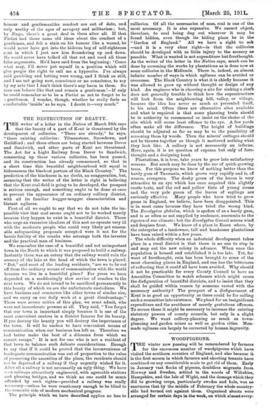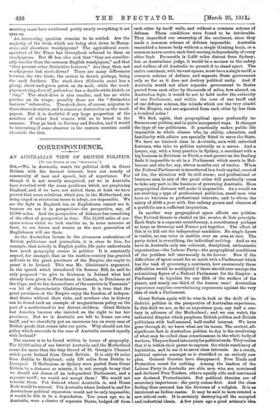WOODPIGEONS.
THE winter now passing will be remembered by farmers for the enormous number of woodpigeons which have visited the southern counties of England, and also because it is the first season in which farmers and shooting tenants have combined on any considerable scale to get rid of them. Early in January vast flocks of pigeons, doubtless migrants from Norway and Sweden, settled in. the woods of Wiltshire, Hampshire, and the Isle of Wight, and the damage which they did to growing crops, particularly swedes and kale, was so enormous that by the middle of February the whole country- side had turned. out against them. Organised shoots were arranged for certain days in. the week, on which almost every7
body possessing a gun took up some position in the afternoon and at nightfall, with the idea of keeping the pigeons perpetually on the move and preventing them from settling in the woods. This organised shooting bad the result of sending the birds in large numbers into the neighbouring counties, so that the migrant flocks which had settled in other parts were joined by wanderers from Hampshire and Wiltshire, and eventually almost the whole of the south of England had declared war against woodpigeon. The Board of Agriculture on March 17th issued a Memorandum advising concerted action in all districts affected for the fortnight beginning on March 20th, and if the Board's advice is followed there will still he organised shooting going on in April—a date by which, as a rule, guns have long been put aside. Woodpigeons provide very good shooting; but in this case, of course, the object is not sport but destruction.
These large migrations of pigeons to England from northern Europe have long been a feature of our English winter. The birds, as a rule, arrive in the middle of December, flying in enormous flocks and distributing themselves throughout wooded country, particularly beechwoods. The numbers of the migrants, however, vary considerably: in some years they are hardly noticed, and in others, such as the present winter and the winter of 1907-8, the numbers are prodigious. In December, 1907, for instance, flocks were recorded passing over the eastern counties, and were estimated by those who saw them at forty or fifty _thousand ; one flock, which was observed flying at a great height and took eight minutes to pass, was described in the usual formula as darkening the sky. But the migration of the present year differs in an important and rather curious particular from the migrations of 1907-8. In that year the flocks of foreign pigeons were attacked by the disease known as diphtheritic roup, and died in thousands. It was impossible to go out in the woods of the southern counties without coming across dead or dying birds ; often the ground under the trees where the birds roosted was white with the feathers of birds which had fallen dead dur- ing the night. Mr. W. D. Mackenzie, writing to the Field from Fawley Court, Henley-on-Thames, in January, 1908, mentioned that out of a flock which had arrived in December, his keepers had picked up in two days 1,142 dead, which he had had burnt. But this year there have been no reports of diphtheritic roup on a large scale, although the disease is believed to be contagious and to be partly due to overcrowding. Possibly the height of the curve of the numbers necessary to produce overcrowding has not yet been reached, and we may have to wait until next year for the remedy ordained by nature against excessive numbers ; pos- sibly the thinning process which is now going on may maintain the numbers of the birds at a healthy level, and there will be another vast migration of birds in fine condition to our shores next winter, which in turn will have to be attacked and thinned down. That would be a rather remarkable result of this year's energetic measures of destruction.
The woodpigeon, for all his faults from the farmer's point of view, is a most attractive bird, interesting for his very wickedness apart from his beauty and his stalwart habits. He is one of the cleverest and wariest of birds ; everybody who has tried to stalk him in a wood knows the sound of the sudden clatter of his wings from the branches, and recognises his skill in invariably putting the tree between himself and the gun. In the early days of spring his courting flight is one of the most beautiful sights of English woods ; the bird soars up from the roof of the trees below him, floats down on spread wings, soars up with three beats of his strong pinions and floats down again—it is an effortless endless motion, as one flies in dreams. Nor has any English bird of his size a sweeter note; the croon of woodpigeons, the repeated Talc' two coos, tale two, from some deep bower of oaks or elms, belongs to the serenest hours of spring and summer afternoons. But the woodpigeon is not only a lusty and a sweet-throated bird; he sets also some very considerable scientific problems. We see him to- day, for instance, at a definite stage of his evolution from common type; he is giving up, or has given up, the habits of his congeners, the stock-dove and the rock-dove, and is making habits for himself. The stock-dove and the rock-dove nest in caves or in holes in tree-trunks (stocks) And lay whi'e eggs; the woodpigeon has left the dark and the hole, and builds out in trees in the open, but woodpigeons still lay white eggs. At some time later, when they have had an aeon or two to develop on lines which other birds have followed since the day when, perhaps, all birds laid white eggs, like snakes woodpigeons' eggs will probably be coloured or speckled like thrushes' and crows', so as to suit their ripen-air surroundings better. The woodpigeon shows himself, already, an extremely adaptable bird. He has realised, for instance, that however unkindly he may be persecuted in the country, in London ha is as safe as a house, and in the London parks he will hardly get out of your way if you meet him on the grass, and will walk under your chair while you have tea. Another curious piece of behaviour in London parks is that on hot days he will occasionally settle actually on the water to drink. Wood- pigeons have on several occasions been noticed to do this, and then to fly away with beats of their wings along the surface, like coots or moorhens. Nor, in London, has he yet settled where he is going to nest. Perhaps in some strange way throwing back to the days when he chose the ledge of a cave, he now occasionally prefers buildings to trees, and he has even nested on the window-sill of a room in daily use ; the owners of the room considerately would not have the window opened. He has a wide range for his breeding season, too, in this showing, even in his wildest state, some likeness to domesti- cated pigeons ; a nest has been found with eggs on January 28th, and there are frequently young pigeons unable to fly late in October or even in early November. These, however, generally die in the nest.
One characteristic does not alter, and that is his insatiable appetite. It is, unfortunately for his reputation, an appetite which is almost entirely destructive. He does infinite damage to the farmers' crops through every season of the year. The prayer of the peasant of the French Revolution who asked to be delivered from pigeons, rabbits and monks, still finds an echo in the vows of the British farmer. One, he said, ate up his crops in the ear, one in the blade, and the last in the sheaf. Monks may not mulct him in the sheaf, and he has the Ground Game Act to help him with the blade, but the seed still needs all the protection he can find for it. The contents of a woodpigeon's crop seldom include anything except what is valuable to a farmer. Occasionally, in May and June, the woodpigeon seems to take to a diet of caterpillars—probably when other food supplies are hard to come by. Two pigeons were sent to the Field office for examination last June, for instance, by a cor- respondent who pointed out that he had often found the crops of woodpigeons crammed with leaf-destroying cater- pillars. The crop of one of these pigeons contained 189 larvm of the Dotted Border and Mottled Umber moths, whose caterpillars feed on oak leaves and often in June strip the trees bare. But the woodpigeon's preferences are not always so innocent. His taste in spring is for young clover and the green of swedes, and in towns and parks, where he cannot get these, he makes shift with opening buds. Almond trees suit him, and he is extremely fond of hawthorn, par- ticularly the buds of double-flowered thorns. The Rev. G. C. Richards, of Oriel College, once told Mr. Warde Fowler that he had noticed that woodpigeons would reject single blossoms for double, selecting those of the deepest hue Another dainty which the bird occasionally chooses is the flower of the horse chestnut. As for his voracity, he will fre- quently fill his crop with more than he can digest. The ground under which pigeons roost in winter has been found scattered with rejected pellets of undigested turnips ; the pellets were disgorged just as owls disgorge the bones and fur of mice and rats. The amount which a pigeon's crop can hold is amazing. A. crop which was opened by Mr. W. B. Tegetmeier in September, 1905, contained 190 small land snails, all living, 25 grains of barley, and 12 of wheat; another bird, shot at East Hoathly, had in its crop 198 beans and a dozen small snails ; the crop weighed 41 oz. A thousand grains of corn have been found in a single crop, and Mr. F. W. Frobawk has recorded an instance of a crop in which he counted 156 whole beech-nuts and the fragments of many others. He shot another bird at Hockley, in Essex, whose crop held 370 grains and a great number of husks of wheat, 4 seed-pods (full) of the dog-violet, 6 peas and half a pea-pod, 9 pieces of clover leaves, 1 seed, 1 small stone, 4 snails (Helix caperata), and 1 parasitical fly (Ornithomyia avicularia). The bird that morning must have swallowed pretty nearly everything it set eyes on.
An interesting question remains to be settled. Are the majority of the birds which are• being shot down in Hamp- shire and elsewhere woodpigeons P The agricultural corre- spondent of the Times has throughout referred to them as woodpigeons. But lit has also said that "they are consider- ably smaller than the common English woodpigeon," and that " they present other distinctive features." Are they, then, not woodpigeons but stock-doves P There are many differences between the two birds, the easiest to detect, perhaps, being the neck feathers. The stock-dove (Columba auras) has a glossy, claret-and-green patch on its neck, while the wood- pigeon or ring-dove (C. palumbus) has a double white blotch, or "ring." The stock-dove is also smaller, and has no white patches on its wings : possibly these are the " distinctive features " referred to. The stock-dove, of course, migrates to these shores in winter, and is almost as destructive as the wood- pigeon. But it is doubtful if any large proportion of the numbers of either bird remain with us to breed in the summer. They go back to Norway and Sweden, and it would be interesting if some observer in the eastern counties could chronicle the date.












































 Previous page
Previous page